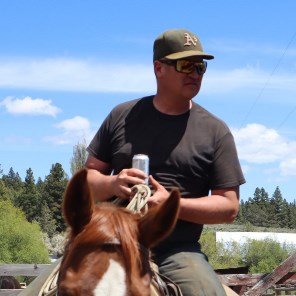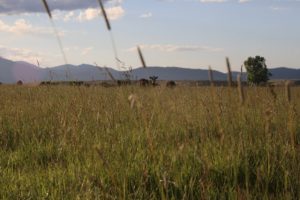This Guest Article for REVITALIZATION was written by Rich Bradbury.
There is a classic book written by a French biochemist and farmer, André Voisin. This book titled, Grass Productivity was written in 1951, and became a holy text for the pioneers of the sustainable ranching movement that began emerging out of New Mexico in the early 1980s.
To this day, his book is one of the most influential in spawning the regenerative agriculture movement. Voisin has a general rule of thumb when it comes to the management of pastures and his Holstein dairy cows which is: “The livestock under the pasture is twice as heavy as that above.”
It is challenging to parse whether Voisin was a scientist, philosopher, revolutionary, or oracle. But sixty-three years later, we know that he played a significant role in shaping regenerative agriculture by preceding other enduring agricultural thinkers of the movement, including Allan Savory: an ecologist and livestock farmer from Zimbabwe, and president and co-founder of the Savory Institute, Joel Salatin: author, lecturer, and direct-marketing farmer, and Fred Provenza: Professor Emeritus of Behavioral Ecology from the Department of Wildland Resources at Utah State University.
Genius or heretic?
André Voisin also forecasted the connection between the health of society and the health of our soils. In his lesser-known and most controversial work, Soil, Grass, and Cancer: The Link Between Human and Animal Health and the Mineral Balance of the Soil, Voisin tried to warn us of how the well-being of the socioeconomically advantaged would collapse as soil health diminished.
As the demands of urban populations strained the resources supporting our food supply, we found a growing number of consumers confronted with an unlearned perspective as to the realities of how their food was grown and raised. There has been a quiet separation from the hinterland. Much of the developed world’s generational ties to agriculture, severed. This has resulted in the bleak consequence that Voisin prophesied: our soil is dying, and civilization has grown increasingly sick.
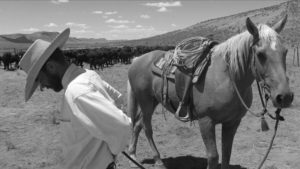 I was raised wild in the embrace of Oregon’s healthy rural ecosystems, so I understand much of this at a gut level. There is an essential rhythm to life that gets lost in progress. As a son of ranching parents, I was shielded from a conventional upbringing. My parents were unique amongst the ranching class that recognized early the public’s evolving desires around their food.
I was raised wild in the embrace of Oregon’s healthy rural ecosystems, so I understand much of this at a gut level. There is an essential rhythm to life that gets lost in progress. As a son of ranching parents, I was shielded from a conventional upbringing. My parents were unique amongst the ranching class that recognized early the public’s evolving desires around their food.
Since the 1980s, our operation embraced holistic resource management, raising cattle without hormones and antibiotics. In the past couple of years, we as a family have begun tackling the obstacle of scaling fresh year-round grass-fed beef to multiple retailers and customers in the Intermountain West and the Pacific Northwest.
When we started selling natural beef in the 1980s, it was about connecting to the health-conscious consumer. Now our role has expanded. Consumers desire a connection back to the source of their food, to the land. We understand that food is a deeply primal experience for customers, and the more they understand about the less-than-transparent manner in which some of their food is being sourced and delivered to their table, the more they use values to guide their purchases when shopping for food to nourish their families.
They need to understand that their food has been humanely treated, and they need to know that it adds real, tangible benefits back to the environment. In short, customers believe the money from their purchases is translating their values back onto the land.
That’s why in 2019, farm and ranch bankruptcies hit an all-time high. Agriculture in America is in peril, and the roots of the fall can directly be connected to soil health.
The onus of soil health failings is disproportionately placed on agriculture. Often amplified as a weakness on the part of ranchers and farmers—two percent of the population is growing food to meet the other ninety-eight percent of the population’s demand for food.
The pressure on our precious agricultural lands continues to grow. Consumers want out-of-season food year-round, robbing the regional resources of other countries. Retailers insist that beef must be grade Choice or above, causing cattle to stay longer and longer in feedlots, creating higher carbon footprints. Farmers and ranchers push to meet increasingly difficult customer driven demands, middleman and retailers drive prices lower.
The choices to fix the failing food system to replenish our soil were once many. Now they are binary.
Two Options
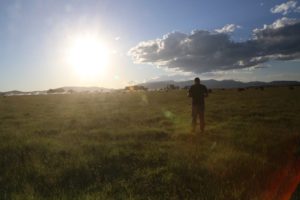 Continue down the “rollback the prices” path and fattening bottom-lines of box-retailers, follow a model anchored on corrupt efficiency. Peak agriculture productivity in its current affirmation concentrates on the costs of the harvest not the cost of remediation to the resource which made those harvests possible. Agriculture lands have productivity limits even when they function naturally.
Continue down the “rollback the prices” path and fattening bottom-lines of box-retailers, follow a model anchored on corrupt efficiency. Peak agriculture productivity in its current affirmation concentrates on the costs of the harvest not the cost of remediation to the resource which made those harvests possible. Agriculture lands have productivity limits even when they function naturally.
Still, we have built entire industries and monolithic corporations on the foundation of a deluded belief that we are just a technological advance away, connecting the loop, and paying down overdue accounts for the resources that have been squeezed to their ends. Our food system is propped up by decades of short-term, make-shift, technical patches. We trade on a future fantasy that the soil ecosystems we have been robbing from can keep pace with ever growing and radically reliant population.
The disruption has been generational, a continuing non-cyclical depletion of our agricultural resources, with a barbaric sense of consequence. Our soils will continue to yield, begrudgingly; produce crops until there is nothing left; until there is not another synthetic super fix to coax away our soils last viability before allowing it to turn to dust.
The other remaining option considers the whole of the natural system. A long-term strategy that replenishes resources is needed to create a foundation for a resilient food system. It is a big idea to communicate, and over the past several decades it has operated in one way or another under many buzzwords, stewardships, conservation, resource allocation, and/or sustainability. It seems that they are all just short of the totality of the undertaking.
Now we have regenerative agriculture.
Regenerative is a multifaceted approach to agriculture that attempts to put back what we have taken and adds vitality back into our soil and ecosystem going into the future.
Regenerative agricultural practices are as described by Regenerative International include:
- Contribute to generating/building soils and soil fertility and health;
- Increase water percolation, water retention, and clean and safe water runoff;
- Increase biodiversity and ecosystem health and resiliency; and
- Invert the carbon emissions of our current agriculture to one of remarkably significant carbon sequestration, thereby cleansing the atmosphere of legacy levels of CO2.
Regenerative agriculture for many seems like a fad that promises a re-balance of power across all stakeholders in the food system. It very well has the potential to be as promised, but skepticism is high, especially amongst those in agriculture.
But regenerative agriculture may not suffer the fate of the other well-intended predecessors. Previous ideologies have broken into pieces the different perspectives of complex systems. Most early initiatives centered around safeguarding the environment, and the business of it all was secondary; fiscal outcomes were relegated to the lowest priority.
Regenerative agriculture, when you strip away the hopeful exuberance of healthier soils, promises of clean and water, and the reestablishment of the idyllic farmscape. The solutions should not ignore the economics of agriculture—the silent gears, turning away, the dirty motivator that never received its subversive due in previous movements.
As a rancher, I find hope in the regenerative movement. In the beef industry, I see a centralization of beef production that runs counter to what value-oriented customers believe they are buying. The marketplace is telling ranchers that the value is in Choice beef, in which cattle spend increasingly longer periods of time in feedlots creating more methane, therefore, moving agriculture toward an ever-expanding carbon footprint.
The beef industry is fractured; once the animal leaves the ranch, the pureness of ranches where it has come from becomes corrupted by weaknesses of the feedlot, packers, and retailers. They drive down the return per pound and ranch families are left with an ever decreasing share of the retail dollar the customers spend to reinvest in agricultural lands and soil.
The solution that regenerative ranching brings to this problem is simple—minimize the role of middlemen. If grass-fed beef is raised on pasture for the entirety of its life, there is no need for feedlots. If we, as ranchers, remove just that input from the equation, then the questions of methane become a much different discussion because the dynamics change from gains in feedlots to benefits on rangelands and pastures. Thus, turning the conversation into one that is beneficial to soil health.
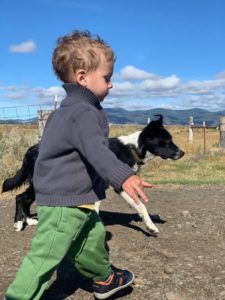 With healthier soils, more carbon is captured from the atmosphere, and less methane is released, because the cattle’s diet begins to more closely mimic nature, and the soil absorbs more methane as the bugs below the soil use more of it for food. The science behind regenerative agriculture provides a path forward to create a food system that is more positive to the environment than one that strips resources and removes vital components from the systems that maintain our planet’s health.
With healthier soils, more carbon is captured from the atmosphere, and less methane is released, because the cattle’s diet begins to more closely mimic nature, and the soil absorbs more methane as the bugs below the soil use more of it for food. The science behind regenerative agriculture provides a path forward to create a food system that is more positive to the environment than one that strips resources and removes vital components from the systems that maintain our planet’s health.
The reality, the clever illusion, that corporations trade on in their marketing campaigns is the mythological persona of the farmers and ranchers, but when there is a breakdown in the product safety, they are just as quick to deflect blame to the very people that produce the raw resources from which they profit.
This brings us back to the Voisin principle that what lies under the pasture must be twice as massive as that which is above. This is one of the paramount failings preventing us from creating a healthy agricultural system, a healthy food system, and a healthier nation. The burden of commerce is backward. What is the bedrock of this food system? Our ranches and farms—they are disproportionately being starved by the corrupt efficiency of multinational agriculture corporations and retailers.
Those closest to the lands bear much of the responsibility for the care and improvement of the resource. All those businesses layered atop the farmer and rancher take and take and take the dollars that are needed to make our farms and ranchlands healthy, creating a circular natural system. Before regenerative agriculture is co-opted by these meddlesome middlemen, it is time to stop and re-image how the economics of a clean and compassionate food system should work.
So, not only can we put healthier food in front of families, but we can also lead the world in creating an anti-fragile agricultural system. One that is based on generational thinking rather than how it will best serve the quarterly reports of multinational agricultural food companies and retailers. It is time to start reflecting and recognize that in the race to feed everyone, we are diminishing critical ecosystems which insure our future.
What those of us in agriculture need to understand—hell, what each stakeholder within the food system needs to recognize—is that regenerative agriculture represents a reorganization of the economy of food, a society-wide capitulation. We need to reverse course and reimagine the way we manage our remarkable agricultural resources.
The long-held belief hunter-gatherers used more energy than the modern 1st world citizen has mostly been disproved. We now understand that the current rise in obesity and skyrocketing healthcare costs are most likely due to the increased consumption of low-quality foods. Regenerative agriculture should be more than just a trendy marketing catchphrase that we shoehorn into uncomfortable conversations about our food system. It should become the prevailing philosophy that is used for the next one hundred years.
I believe that if regenerative agriculture remains democratized and is not allowed to be hijacked by governments, third parties, multinational AG conglomerates, and narrow-minded special interest groups, then it will allow the human race to safeguard the economic well-being of farmers and ranchers, lift more people out of poverty, create healthier ecosystems, and most importantly, put good quality food back on the tables of our families.
Photos courtesy of Rich and Alina Bradbury.
About the Author:
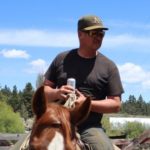 Rich Bradbury is a rancher who runs cattle with his family in Great Basin of the Western United States.
Rich Bradbury is a rancher who runs cattle with his family in Great Basin of the Western United States.
Currently, his focus is on grass-fed beef, regenerative ranchlands, and creating a soil health monitoring program that is practical and actionable for all people in agriculture.
On The Double Oarlock ranch, The Bradbury’s and partners raise cattle, wild hay, birds, deer, and confident, healthy kids with a desire to promote and build resilient regenerative rural communities.
Connect with Rich on LinkedIn.
See the Double Oarlock ranch website.

